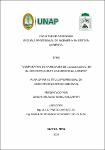| dc.contributor.advisor | Pinedo Jiménez, Julio | |
| dc.contributor.advisor | Meléndez Celis, Ranulfo Segundo | |
| dc.contributor.author | Soria Malaverry, Junior Orlando | |
| dc.date.accessioned | 2023-01-05T18:46:48Z | |
| dc.date.available | 2023-01-05T18:46:48Z | |
| dc.date.issued | 2022 | |
| dc.identifier.uri | https://hdl.handle.net/20.500.12737/8704 | |
| dc.description.abstract | Lettuce is one of the most consumed olive species in the diet, its cultivation is generally carried out in a conventional system, protection horticulture such as hydroponics allows to improve its vegetative adaptation and yield; the main objective was to determine the effect of sunlight intensity on the 3 types of varieties of Lactuca sativa. The nursery was made on a moistened sheet of paper towel, then after 5 days each seedling was placed in a sponge cube accommodated in a Styrofoam float fed in a source of nutrient solution, after 10 days they were transplanted to the 3” PVC tubes distributed at 1.0 m above the ground, each tube was fed with a circular flow sheet of nutrients, until harvest at 35 days.
To evaluate the behavior and characteristics of the 3 lettuce varieties, there is a significant effect (p<0.01) between varieties for height, plant width, stem diameter, root length, number of leaves and root weight.
In relation to the development of lettuce varieties grown in the NFT hydroponic technique under tropical climatic conditions, comparing the growth and development of agronomic characteristics and yield in order to improve horticultural technologies for protection against climate change in Loreto, it was evidence that the varieties show significant statistical significance in the vegetative behavior, being in this experiment the Tropicana variety with the highest plant weight (100.63 g). | en_US |
| dc.description.abstract | La lechuga es una de las especies olerícolas de mayor consumo en la dieta alimenticia, generalmente su cultivo se realiza en un sistema convencional, la horticultura de protección como la hidroponía permite mejorar su adaptación vegetativa y el rendimiento; el objetivo principal fue determinar el efecto de la intensidad de luz solar en los 3 tipos de variedades de Lactuca sativa. Se realizó el almácigo en una lámina humedecida en papel toalla, luego a los 5 días a cada plántula se le colocó en un cubo de esponja acomodada en un flotador de Tecnopor alimentada en una fuente de solución nutritiva, a los 10 días se trasplantaron a los tubos de PVC de 3” distribuidos a 1.0 m de altura del suelo, cada tubo fue alimentada con una lámina de flujo circular de nutrientes, hasta el momento de la cosecha a los 35 días.
Para evaluar el comportamiento y características de las 3 variedades de lechuga hay efecto significativo (p<0.01) entre variedades para altura, ancho de planta, diámetro de tallo, longitud de raíz, cantidad de hojas y peso de raíz.
En relación al desarrollo de las variedades de lechuga cultivadas en la técnica hidropónica NFT bajo condiciones climáticas tropical, comparando el crecimiento y desarrollo de las características agronómicas y el rendimiento a en el propósito de mejorar tecnologías hortícolas de protección frente al cambio climático en Loreto, se evidencia que las variedades muestran significancia estadística significativa en el comportamiento vegetativo, siendo en este experimento la variedad Tropicana con mayor peso de planta (100.63 g). | es_PE |
| dc.format | application/pdf | es_PE |
| dc.language.iso | spa | es_PE |
| dc.publisher | Universidad Nacional de la Amazonía Peruana | es_PE |
| dc.rights | info:eu-repo/semantics/openAccess | * |
| dc.rights.uri | https://creativecommons.org/licenses/by/4.0/ | * |
| dc.subject | Sistemas de cultivo | es_PE |
| dc.subject | Rendimiento de cultivos | es_PE |
| dc.subject | Cultivo hidropónico | es_PE |
| dc.subject | Lechuga | es_PE |
| dc.subject | Lactuca sativa | es_PE |
| dc.title | Comparativo de variedaes de Lactuca sativa L. en el comportamiento en hidroponía, Loreto | es_PE |
| dc.type | info:eu-repo/semantics/bachelorThesis | es_PE |
| thesis.degree.discipline | Ingeniería en Gestión Ambiental | es_PE |
| thesis.degree.grantor | Universidad Nacional de la Amazonía Peruana. Facultad de Agronomía | es_PE |
| thesis.degree.name | Ingeniero(a) en Gestión Ambiental | es_PE |
| dc.subject.ocde | https://purl.org/pe-repo/ocde/ford#4.01.06 | es_PE |
| renati.author.dni | 72803428 | |
| renati.advisor.orcid | https://orcid.org/0000-0001-6784-0803 | |
| renati.advisor.orcid | https://orcid.org/0000-0002-7783-2273 | |
| renati.advisor.dni | 05248692 | |
| renati.advisor.dni | 05373178 | |
| renati.type | https://purl.org/pe-repo/renati/type#tesis | es_PE |
| renati.discipline | 521236 | es_PE |
| renati.level | https://purl.org/pe-repo/renati/level#tituloProfesional | es_PE |
| renati.juror | Manrique del Aguila, Julio Abel | |
| renati.juror | Yalta Vega, Ronald | |
| renati.juror | Avila Fucos, Manuel Calixto | |
| dc.publisher.country | PE | es_PE |


